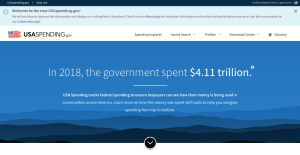Just the facts: The government’s data gets a clearer window at USAFacts
Since it launched a little more than a month ago, USAFacts.org has captured a lot of attention, inside and outside of the public sector, for all the information it offers up on how the government spends its money and the results it sees.
Unlike other government-led initiatives to make information available to the public, USAFacts.org, the brainchild of former Microsoft president Steve Ballmer, is heralded as a much more accessible and user-friendly trove of ready information that allows the average non-techie layman to quickly dig up statistics or comparative data going back more than 30 years in most cases.
You want to know how the number of active duty military members stacks up to 1977: One easy search will tell you that the number has fallen from just over 2 million 40 years ago, to roughly 1.3 million members last year.
Do you care to track how the high school dropout rate has decreased in most cases since 1980, or how dropout rates compare based on race, gender, or income? Handy line charts outline this evolution in ways that even the least tech-savvy user can contemplate.
“Our aim was to assemble a common set of data to serve as a platform for serious, informed debate about government finances and outcomes,” says Christine Heenan, spokesperson for USAFacts.org.
The initiative was inspired by a conversation founder Ballmer had with his wife, Heenan says, reciting a tale that has (at this point) taken on almost legendary tones:
In addition to buying the Los Angeles Clippers basketball team, when Ballmer retired as president of Microsoft in 2014 at the age of 57, his wife “wanted him to more actively engage in their philanthropic work, and he thought it made sense to first find out what government does with the money it takes in,” Heenan says. “Given his business background, he went looking for something akin to a Form 10-K for government that would lay out government spending, revenues, and outcomes by type of activity.”
When Ballmer could not find that level of transparency in details surrounding government spending, he set out to create it.
Heenan says the intent of the USAFacts.org is to “spur people to engage more deeply with facts and figures about government. We hope it will help them learn more about what government does—and why government matters to them.”
“We also hope that by shining a spotlight on the excellent data government agencies collect,” Heenan says, “we can help bolster public support for their data-collection efforts, and smart use of good data to drive policymaking.”
Michael L. Wyland, a founding partner of Sumption & Wyland, a consulting firm that advises nonprofits, sees the creation of USAFacts.org as “a very interesting and intriguing development. Most of us have known for a long time that the government puts out a lot of information. There’s an information overload,” Wyland says. “But putting it in reasonable sense for analysis … the same way a business would want to view it, has been too much.” Until now.
And, since the data is being organized by an outside, non-government-related entity, Wyland says there is less fear of an “agenda” shaping the way the information is presented (to paint a particular government agency or sector or political party in a better light than another). Indeed, USAFacts.org is deemed as the “first nonpartisan effort to create a fully integrated look at revenue and spending across federal, state and local governments.”
Ballmer is reported to have spent more than $10 million so far in personal funds and grants on this endeavor, registered as a nonprofit corporation in the state of Washington. Partners on USAFacts.org include University of Pennsylvania’s Wharton School of Business, the Stanford Institute for Policy Research, and Lynchburg College. Seattle-based design studio Artefact helped design the site, organizing it to make it as user-friendly and clear as possible.
To be sure, this is not the first open data effort on government spending. The U.S. government itself launched Data.gov in 2009 to centralize information, and in 2014, former President Barack Obama passed the DATA Act to improve record-keeping standards.
Data.gov is the federal open data site, containing metadata that the federal agencies make available to the public, much like a “card catalog” that helps users discover data. The data sets themselves are hosted on the applicable agency’s website. The Data.gov program works mainly with the open data leads at federal agencies to make sure their metadata is properly included in the Data.gov catalog, and the catalog covers a wide spectrum of subjects. It is not focused on spending data, which is the focus of usaspending.gov, operated by the Department of the Treasury.
Similarly, startup OpenGov has been working to make local government records more accessible since 2015.
Since its launch less than two months ago, USAFacts.org has received over 1,500 emails from people who have visited the site and have questions or ideas, Heenan says. “Some just offer notes of gratitude, some offer useful feedback — one even caught a rounding error,” she says. “I think it’s too early to say we’ve changed the way people view government data, but a terrific outcome of this effort would be for more people to look up and use government numbers, since as Steve says, numbers tell a story. Our long-term hope is to show that government collects a wealth of interesting, accurate, useful data that should help drive policy decision-making.”
It has not been an easy road to information openness. According to Heenan, one challenge was the variety of formats that data come in: PDFs, web tables, confusing download portals. Another challenge was that funding for research “ebbs and flows, so there might be a consistent survey for a decade that then ends for a few years and then re-starts on an every-other-year schedule. Or, the survey is re-vamped, so that the data can’t be directly compared to past surveys.”
Finally, a key question in creating USAFacts was how to organize government activities into “segments,” to borrow the language of a corporate 10-K. “Should we use the Congressional committees of jurisdiction? Some other taxonomy?” Heenan says. “We decided to take the stanzas in the Preamble to the Constitution and use them as a constitutional charter that lays out the distinct missions of government.”
Wyland points out that in making government spending data more readily understood and transparent, this initiative could well make federal and state agencies more accountable to their constituents, since they will be able to more readily view their government spending habits. “Some people in government agencies are not going to be very happy and may look for ways to obfuscate the data at the source,” he says. “Are we going to see more [items] listed as miscellaneous or programs cited as a unallocated or undesignated?”




